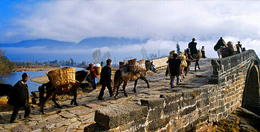Bridging Culture and Cuisine in Yunnan China
Editor's Note: China is divided into as many culinary regions as there are different ethnic groups. Its geographical diversity and kaleidoscopic cultural profiles contribute to the unending banquet of flavors.
About 15 years ago, we decided to buy a house in Kunming, Yunnan, in the southwest of China. We thought it would make an excellent retirement retreat.
Yunnan is a relatively quiet province, with few urban attractions or bright city lights. Instead, it boasts startlingly beautiful scenery and mild weather throughout its length and breadth and is well known as an international tourist destination.
How can you even argue with a place that has Shangri-La as one of its attractions? And we haven't even started on its list of UNESCO World Heritage sites.
For me, however, it is Yunnan's ethnic diversity that makes it feel like home. Of the 56 official ethnic groups that make up the demographic profile of China, almost half can be found in our adopted province.
There is a graceful tolerance prevalent in Yunnan seldom seen elsewhere. Yi and Bai, Hani, Dai, Tibetan, Naxi and Mosuo live right next to each other in town and country, sharing each other's tribal customs, festivals and food. That's excluding the other dozen or more tribal communities scattered all over this high-altitude plateau province.
Perhaps it is for this reason that people in Yunnan have found it very easy to accept outsiders from early on. From the first French and English missionaries in the late 19th century, adventurous plant hunters and botanists like Joseph Rock, volunteer US Flying Tigers during World War II, to present day Scandinavian and European enclaves doing business and teaching English all over Yunnan, foreign influences are seen, felt and appreciated.
Apart from the happy harmony, it is the food that best reflects Yunnan's colorful psychographics. And there is none more representative than one single noodle dish.
It stands out as Yunnan's most recognized culinary signature, and visitors consider it a wasted trip if they did not sample it at least once.
Over the Bridge Noodles, or guoqiao mixian, is a dramatic presentation.
A dozen little platters holding a variety of raw and cooked ingredients are first placed on the table together with a serving of rice vermicelli in a large bowl. A steaming hot bowl of chicken soup follows.
This is where the fun begins.
The soup is almost smoking in its intensity, but you don't realize how hot it is until you combine the thinly sliced meat and vegetables in the bowl of vermicelli and pour it on.
It cooks everything instantly.
This dish also has a folk legend behind it that reflects the Yunnan respect for scholarship.
Once upon a time in Mengzi county near the UNESCO World Heritage rice terraces of Yuanyang, there was a scholar who was more concerned with lazing around and composing odes to the mountains and hills than doing something concrete.
In those days, the quickest shortcut to fame and fortune was to sit for the Imperial examinations held once every three years.
If you scored well, you became a court official immediately, but the arduous process involved studying for tests at village, county, provincial and, finally, national levels.
Our scholar's wife kept encouraging her reluctant spouse to sit for the examinations, going out of her way to find a nice quiet cottage for him so he could concentrate on his studies. She also cooked for him every day.
But the distance from home to cottage meant a long journey over several bridges and food became cold. She racked her brains on how to serve him piping hot food and hit upon this recipe of pouring hot chicken soup onto cold noodles.
The chicken soup, made from the local silky chickens, was kept hot under the surface layer of oil.
After a year of chicken soup and noodles, the scholar set off on his long journey to the Imperial examinations, and it goes without saying that he did very well.
But I still think it was his wife who had the brains.
These days, Over the Bridge Noodles are no longer just another home-cooked dish. They are served all over the province, from lowly farmers market pop-up stalls to lavishly decorated specialty restaurants.
If you visit Yunnan anytime soon, you will be tasting this delicious dish, so here is an insider guide to the proper way to eat it.
On the little plates will be thinly sliced pork loin, chicken breast, squid with blanched pig kidneys, Yunnan ham and tripe. Accompanying them will be pea and alfalfa shoots, chives, coriander shoots, spring onion and ginger julienne. There will also be a tiny plate of finely shredded bean curd.
A raw quail's egg is placed by the side, as well as condiments such as soy sauce, sesame oil, salt, pepper and the Yunnan favorite - hot chili oil.
First, take the wafer-thin pork and chicken slices and coat them in the beaten quail's egg. Season with salt or soy sauce. Then spread out the raw marinated meat on top of the rice noodles, followed by the other ingredients in this order: raw meat, cooked meat, tofu, green vegetables.
Now for the dramatic moment. Carefully pick up the hot bowl of chicken soup and pour it over the noodles. You will instantly see all the raw meat turn color and cook.
Don't be impatient. The soup is still scaldingly hot, and you have to mix the ingredients and noodles thoroughly to bring the soup down to an edible temperature.
Once you've eaten a bowl of smooth slippery rice noodles in that bowl of rich chicken broth, you'll be fortified for the tasks ahead, visiting all of the various cultural and historical relics for which Yunnan is famous.
And I should mention you've already slurped up a slice of epicurean history, since that bowl of Over the Bridge Noodles was officially listed as one of China's Intangible Cultural Heritages in 2008.














